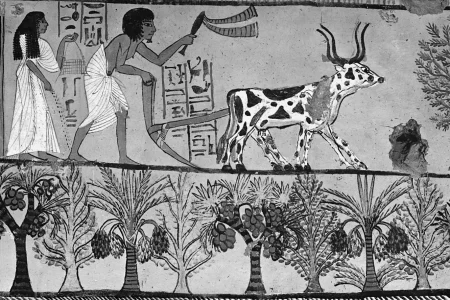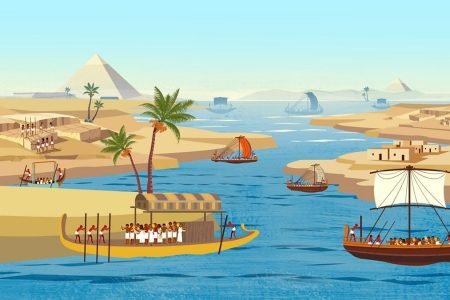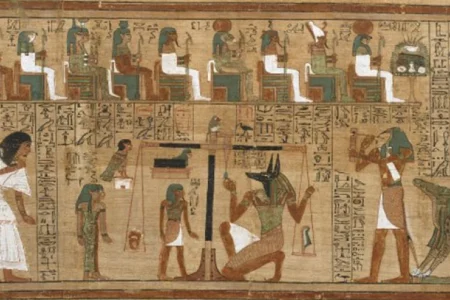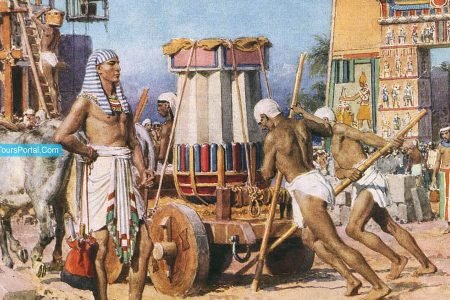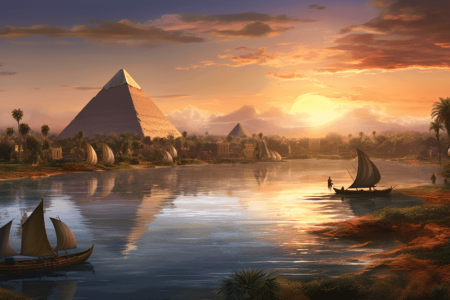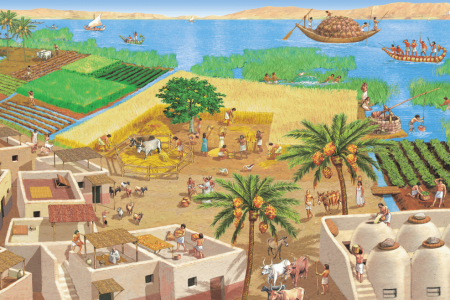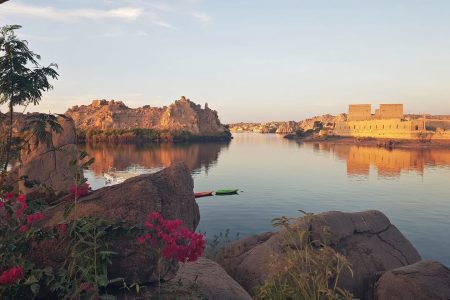The Nile River, one of the longest and most important rivers in the world, played a central role in the development of ancient Egyptian civilization. Far more than just a river, the Nile was the lifeblood of Egypt, supporting the country’s agriculture, economy, transportation, and even religion. The river’s annual flooding, its fertile soil, and its vital waters allowed ancient Egypt to flourish as one of the greatest civilizations in history. This article explores how the Nile River was essential to Egypt’s development and the lives of its people, shaping everything from their economy to their spiritual beliefs.
- Egypt Tour Magic
- Egypt Tour Packages
- Excursions in Egypt
- Cairo Tours and Excursions
- Hurghada Tours and Excursions
- Soma Bay Tours and Excursions
- Makadi Bay Tours and Excursions
- Sahl Hasheesh Tours and Excursions
- El Gouna Tours and Excursions
- Marsa Alam Tours and Excursions
- Port Ghalib Tours and Excursions
- El Quseir Tours and Excursions
- Dendera and Abydos Day Tours
- Aswan Tours and Excursions
- Luxor Tours and Excursions
- Alexandria Tours and Excursions
- Sharm El Sheikh Tours and Excursions
- Top Rated Tours in 2025
- Optional Excursions in Egypt
- Private Transfer
- Blogs About egypt
- Ancient Egypt
- What You Need To know Before Your First Trip To Egypt
- Best Places to Visit in Egypt 2025
- Top Attractions in Red Sea Resorts 2025
- Top 10 Tourist Activities in Egypt
- Top 30 Activities You Can’t Miss in Egypt
- The Guide to Guided Tours in Egypt
- Egypt’s Ancient and Modern History
- The Nile River
- The Deserts of Egypt
- Historical Sites in Egypt
- Cairo
- Alexandria
- Luxor
- Aswan
- The Red Sea
- Dendera Temple
- El Fayoum Oasis
- Bahariya Oasis
- Siwa Oasis
- Al Alamein
- Marsa Matruh
- Ancient Egyptian gods
- famous Egyptian dishes
- UNESCO World Heritage sites
- About Us
- Why Egypt Tour Magic
- Egypt Tour Magic
- Egypt Tour Packages
- Excursions in Egypt
- Cairo Tours and Excursions
- Hurghada Tours and Excursions
- Soma Bay Tours and Excursions
- Makadi Bay Tours and Excursions
- Sahl Hasheesh Tours and Excursions
- El Gouna Tours and Excursions
- Marsa Alam Tours and Excursions
- Port Ghalib Tours and Excursions
- El Quseir Tours and Excursions
- Dendera and Abydos Day Tours
- Aswan Tours and Excursions
- Luxor Tours and Excursions
- Alexandria Tours and Excursions
- Sharm El Sheikh Tours and Excursions
- Top Rated Tours in 2025
- Optional Excursions in Egypt
- Private Transfer
- Blogs About egypt
- Ancient Egypt
- What You Need To know Before Your First Trip To Egypt
- Best Places to Visit in Egypt 2025
- Top Attractions in Red Sea Resorts 2025
- Top 10 Tourist Activities in Egypt
- Top 30 Activities You Can’t Miss in Egypt
- The Guide to Guided Tours in Egypt
- Egypt’s Ancient and Modern History
- The Nile River
- The Deserts of Egypt
- Historical Sites in Egypt
- Cairo
- Alexandria
- Luxor
- Aswan
- The Red Sea
- Dendera Temple
- El Fayoum Oasis
- Bahariya Oasis
- Siwa Oasis
- Al Alamein
- Marsa Matruh
- Ancient Egyptian gods
- famous Egyptian dishes
- UNESCO World Heritage sites
- About Us
- Why Egypt Tour Magic
The Nile River: The Lifeblood of Ancient Egypt
1. The Primary Source of Agriculture
The Nile River was essential for agriculture in ancient Egypt. The river’s annual flooding brought nutrient-rich silt and minerals that made the surrounding soil highly fertile, creating ideal conditions for farming. Without the Nile, the harsh desert landscape would have been inhospitable for large-scale agriculture.
Egyptians relied on the Nile’s water to irrigate crops such as wheat, barley, flax, and various fruits and vegetables. Agriculture was the backbone of ancient Egypt’s economy, and the Nile played a pivotal role in supporting this vital sector. The river’s annual floods provided the necessary irrigation and replenished the land with nutrients, which allowed for the cultivation of staple crops that sustained the population.
2. Transportation and Trade
The Nile was Egypt’s primary transportation route. Unlike other civilizations that relied heavily on roads, ancient Egyptians used the river to move goods, people, and armies. The river’s steady flow facilitated both travel and trade, connecting Egypt’s Upper and Lower regions and linking the country with other lands.
In ancient Egypt, boats and ships were the primary modes of transportation. Egyptian merchants used the Nile to transport grain, papyrus, linen, and other goods to distant regions. Additionally, the Nile allowed for the export of Egyptian products to neighboring countries and trade with foreign nations such as Mesopotamia, Nubia, and the Mediterranean regions. It was also a vital link for military campaigns and troop movements, ensuring that Egypt’s military could maintain control over its vast territory.
3. Religion and Spiritual Beliefs
In ancient Egyptian religion, the Nile River was not just a physical feature; it was a divine presence. The river was worshipped as a god in its own right, known as Hapi, the god of the Nile, who symbolized fertility, abundance, and prosperity. The Egyptians believed that the flooding of the Nile each year was a gift from the gods, ensuring that the land remained fertile and capable of producing crops.
The annual flooding, known as the “inundation,” was seen as a manifestation of divine favor, and Egyptians held religious ceremonies to honor Hapi and other gods who were believed to control the river’s flow. Temples and altars were built along the Nile’s banks, and religious leaders often performed rituals to ensure that the flooding occurred at the right time and in the right amount to sustain the agricultural cycles.
4. Economy and Trade Networks
The Nile was not only vital for Egypt’s domestic agriculture but also played a significant role in Egypt’s economy through its trade networks. The river facilitated the movement of goods both within Egypt and between Egypt and foreign lands. Trade was essential to Egypt’s prosperity, and the Nile made it possible to exchange goods such as grain, gold, and papyrus with other civilizations.
Egyptians traded extensively with peoples from regions like Nubia, the Levant, and the Mediterranean, exporting agricultural products, luxury goods, and materials like papyrus. In return, they imported raw materials like timber, incense, and metals, contributing to the economy’s growth and allowing Egypt to develop as a powerful and wealthy nation.
5. The Annual Inundation: A Sacred Event
One of the most important events for the ancient Egyptians was the annual flooding of the Nile. Every year, the river would flood its banks, inundating the surrounding land with water and fertile silt. This inundation was crucial for agriculture and was seen as an event of divine significance.
The Egyptians developed sophisticated systems to manage the Nile’s floodwaters, ensuring that the crops could be irrigated and the land fertilized. The flooding was not only a practical necessity but also a religious symbol, as the Egyptians believed it represented the tears of the goddess Isis or the god Osiris, bringing life and fertility to the land. The timing and extent of the flood were eagerly anticipated, as it directly affected the success of the harvest and the overall prosperity of Egypt.
6. Social Life Along the Nile
The life of the ancient Egyptians was deeply intertwined with the Nile River. The riverbanks served as the foundation for much of Egypt’s social and urban life. Most of Egypt’s cities, including the capital cities of Thebes and Memphis, were located near the Nile, allowing people to take advantage of the river’s resources. The river also provided a source of fish and other aquatic life, contributing to the diet of ancient Egyptians.
The Nile’s importance in social life can also be seen in its role in festivals and celebrations. The annual Opet Festival, held in Thebes, was one of the most significant religious events, during which statues of gods were paraded along the Nile to ensure the fertility of the land. The river served as a cultural and social gathering point for many Egyptians, fostering a sense of community and connection to the divine.
7. Engineering and Innovation
Ancient Egyptians were masters of engineering, and their ability to manage the Nile’s water resources is a testament to their ingenuity. The Egyptians built complex irrigation systems, including canals and basins, to control the flow of the river and direct water to the fields that needed it most. These innovations allowed Egypt to thrive as an agricultural powerhouse, supporting a large population and maintaining the empire’s wealth.
The construction of massive reservoirs and irrigation channels also ensured that the floodwaters were efficiently managed, which was crucial for sustaining Egypt’s agriculture during the dry seasons. The successful use of the Nile’s resources by the ancient Egyptians is one of the many examples of their ability to harmonize their society with the natural world.
8. The Nile as Egypt’s Lifeblood
The Nile River was more than just a geographical feature for the people of ancient Egypt—it was the foundation of their civilization. From agriculture and trade to religion and daily life, the Nile was integral to every aspect of Egyptian culture. It nourished the land, connected distant regions, and provided the means for Egypt to develop into one of the most advanced and powerful empires of the ancient world. The reverence for the Nile, and its role in the prosperity of Egypt, continues to be a key element of Egypt’s identity, both in the past and present.
Today, the Nile remains an essential part of Egypt’s identity and economy, continuing to shape the lives of millions of people who live along its banks. As a vital resource, the Nile continues to symbolize life, fertility, and abundance—just as it did for the ancient Egyptians.


